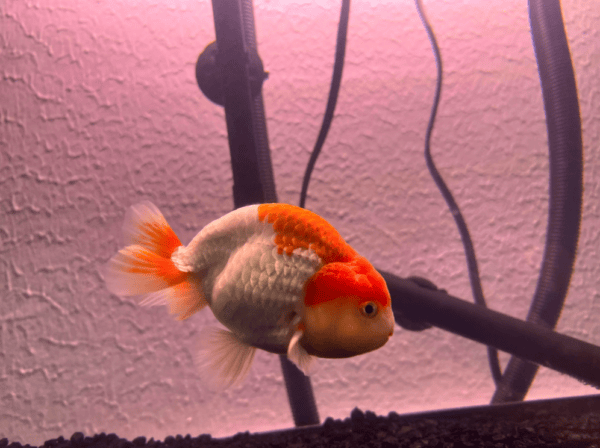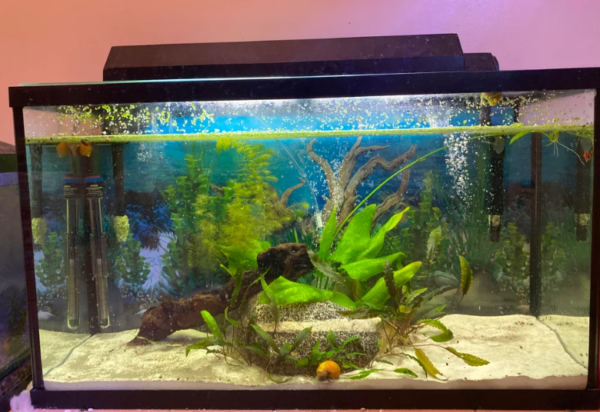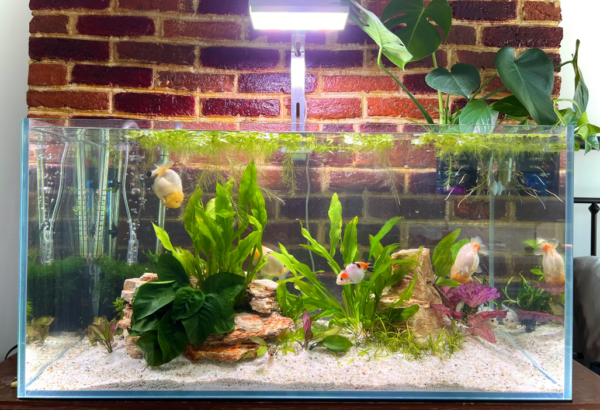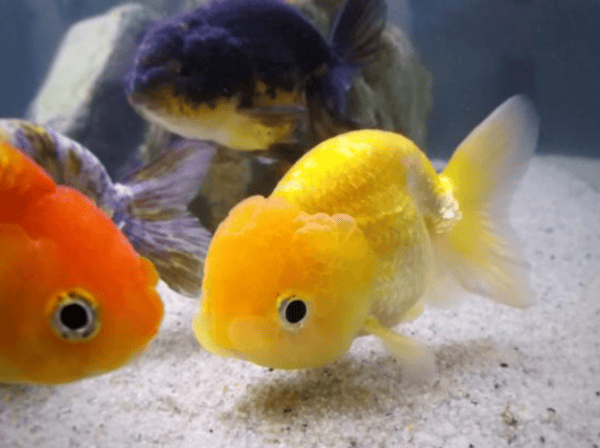Called the King of Goldfish, The Ranchu are known for their large, round bodies, and lack of dorsal fin. Ranchu Goldfish are considered one of the most beautiful and expensive breeds of goldfish, thanks to their fatty wen and vibrant colors.

Ranchu, originating from the word “Ranchi”—meaning curly, demonstrates a restrictive, waddly swimming pattern, thanks to the absence of a dorsal fin. As they’re unable to move out of danger faster, it’s recommended not to keep them with aggressive and fin-nipping fish species.
In this article, we’ll discuss Ranchu Goldfish care, their lifespan, diseases, and all other necessary details that you need to know to sustain a healthy aquarium.
Table of Contents
Ranchu Goldfish Overview
Developed in Japan during the 19th century, the Ranchu is a domestic species of goldfish that has had an extremely successful run to become one of the most sought-after goldfish breeds in the world. While it’s not found in the wild, it’s pretty populous in the artificial waters.
Ranchus are believed to have originated from the Lionhead Goldfish, which also exhibit a similar wen on their head. However, they were selectively bred for larger wen and a more compact body.
| Information Chart | Ranchu Goldfish |
| Scientific Name: | Carassius auratus var. ranchu |
| Family: | Cyprinidae |
| Care Level: | Moderate |
| Temperament: | Peaceful. Overzealous when feeding. |
| Color: | Variety of colors, including red, orange, yellow, black |
| Lifespan: | 10 to 20 years |
| Size: | 6 to 8 inches |
| Diet: | Omnivorous. Flakes, pellets, veggies |
| Minimum Tank Size: | 50 – 60 gallons for a pair |
| Temperature: | 65 to 72F |
| WaterConditions: | pH: 6.5 to 7.5 Hardness – Moderate 5 -19 dGH |
| Tank Mate Compatibility | Other peaceful fish and goldfish |
Ranchu Goldfish Appearance
Ranchus are made to be as compact and unique as possible. They were bred to acclimate to artificial waters and smaller tanks.
Appearance-wise, they have an egg-shaped body with different vibrant colors covering their whole bodies. The colors often include shades of red, orange, white, black, and calico. However, multiple colors may also be present in Ranchu Goldfish.
This species of goldfish also lacks the dorsal fin and has a larger head than its body. The head is wrapped in fleshy wen that often keeps growing larger in size to cover the eyes and nostrils of the fish. So much so, that they often require human intervention to lead a healthy life.
The bigger and more salient the wen is, the more valuable the fish becomes.
Another unique Ranchu feature is its rounded tail. Their tail fin is graciously round and often has a different color than their body, making them stand out more when swimming.
Types of Ranchu Goldfish
Three main types of Ranchu Goldfish are found in domestic settings:
- Japanese Ranchu
This is the most prized Ranchu goldfish and is considered the original. The Japanese Ranchu has a deep body, well-developed wen, and a round tail fin.
- Chinese Ranchu
Chinese Ranchu are similar to Japanese Ranchu, but they have a longer body and less developed wen.
- Thai Ranchu
Thai Ranchu are most recently developed and have a bulbous head and large wen. They also have the smallest body among the Ranchus.
A number of other types of Ranchus, such as the Kyoukai-kei Ranchu, Uni-Kei Ranchu, and Osaka Ranchu, can also be found around the globe.
Lifespan of Ranchu Goldfish
The average lifespan of Ranchu Goldfish revolves around 10 to 15 years, with a few individuals living up to the regal age of 20. While they’re pretty hardy fish and can survive pretty extreme water conditions, they gain an edge when kept in a well-maintained tank with proper nutrition and tank mates.
In most cases, Ranchu goldfish fail to even cross the lower threshold of lifespan due to a lack of care, maintenance, and nutrition by inexperienced aquarists.
Ranchu Goldfish Size
Ranchu goldfish, on average, grow to a massive 6 to 8 inches in size. However, it all depends on the habitat they’re kept in.
For example, in small confined spaces, they may even struggle to reach 3 inches, while they’ve seen to grow to a massive 12-15 inches in outdoor ponds with proper nutrition and care.
They aren’t very challenging to take care of. But you must understand their requirements to unhinge their size potential.
Ranchu Goldfish Care & Tank Set-Up

Ranchu is a pretty forgiving fish species. They can acclimate to a very broad set of water conditions and have been observed to survive pretty harsh neglect. However, we want you to learn and deliver the best possible care to your Ranchu.
1. Ranchu Goldfish Tank Size and Specifications
In this section, we’ll discuss the tank details, including tank size, shape, filter, substrate, and other tips, for Ranchu goldfish.
Optimum Tank Size for Ranchu Goldfish
The optimum tank size for a single Ranchu is 40-50 gallons, with 10 gallons for each additional fish. However, the larger tank you can offer, the better.
Being high-bioload fish, meaning they eat and poop a lot, Ranchu needs a lot of water. In addition, they require powerful filtration systems and water change routines to stay healthy.
Tank Shape for Ranchu Goldfish
A rectangular tank with dimensions 36 inches long, 18 inches wide, and 12 inches tall should be adequate for a single Ranchu. A horizontal tank gives them enough space to swim around and explore the decorations.
However, to accommodate more fish, you need a larger tank with more depth and horizontal space.
Filter Type
As discussed, Ranchu is a pretty high-bioload fish with a demand for powerful filtration systems. Therefore, canister filters with variable flow rates are best suited for larger Ranchu tanks.
We highly recommend that you don’t employ HOB or sponge filters alone to maintain these aquariums. However, you may install them as additional supporting equipment.
Filtration systems can only do so much. Regular water changes are critical to remove the excess nitrates and regulate algae growth. Try to at least do a 50% water change every week and a 100% water change every 4 weeks to keep a pair of happy and healthy Ranchu.
Substrate
Ranchu goldfish aren’t picky about substrates. Keep them in any type of substrate as long as they’re not sharp and abrasive. Sand, smooth gravel, and pea gravel are the best choices.
How Many Ranchu Goldfish in a 50-Gallon Tank?
You can keep 2 Ranchu goldfish in 50-gallon tanks.
2. Water Parameters for Ranchu Goldfish
Maintaining proper pH, GH & KH hardness, temperature, and water flow rate is considered the most critical element of tank maintenance. In this section, we’ll discuss those key details in depth.
Water Temperature
Ranchu goldfish thrive in temperatures between 65 to 72 F or 18 to 22 C. However, evident from their worldwide dominance, they can survive in much lower or higher temperatures.
Despite their forgiving physiology, try to maintain water temperature as close as possible to the optimum range.
Employ heaters or heat pads to increase the water temperature, and increase evaporation or practice water change to reduce it.
Try not to induce temperature shock in the tank. For example, mixing ice cold or boiling hot water directly in the tank in an effort to regulate the temperature.
Water Flow Rate
For your Ranchu goldfish, aim for the lowest possible water flow rate that isn’t zero. They are inefficient and slow swimmers who can’t navigate faster waters without getting physically exhausted.
Because of this, it’s advised to not keep them in a community tank with fast-moving fish species that prefer a greater water flow.
However, with a powerful filter, keeping a lower flow rate may become challenging. Therefore, we recommend a filter with an adjustable flow rate. The flow rate should stay close to 5 times the volume of your tank size.
pH Level
A neutral pH level is preferred by Ranchu goldfish. Again, they may survive a bit of acidic or basic water, but it’s not the range where they thrive. Invest in a good pH meter and follow the tips.
To raise pH, Use crushed corals or dolomite gravel as substrates or in filter media. In addition, you may also use commercial pH accelerators.
To reduce the pH, use RO or DI water while changing water. Driftwood, peat moss, and commercial pH decreasers can also be deemed effective.
Water Hardness
Water hardness of 5-19 dGH is appropriate for Ranchu goldfish. Here are a few tips to maintain water hardness:
- Use Gh and KH commercially available additives.
- Add limestone rocks. It releases minerals into the water.
- Use RO/DI water to decrease hardness.
- Add driftwood.
Proper water hardness is necessary to maintain proper osmoregulation, gill function, and acid-base balance. Your Ranchu may also develop stress and reproductive issues with irregular water hardness.
3. Ranchu Goldfish Tank Landscape

Ranchu goldfish, being explorative and shy in nature, prefer having a lot of vegetation in the tank. They exhibit their playful nature by interacting with the decorations and touching the leaves.
Best Plants for Ranchu Goldfish
Goldfish have a nibbling trait that makes them ill-suited for floating and weaker plants. The best plants for Ranchu goldfish include:
- Anubias
Anubias is a slow-growing, hardy plant that can tolerate Ranchu abuse. Its thick leaves can withstand some nibbling. Anchor them to rocks or driftwood.
- Java Fern
Java fern is another hardy plant with tough leaves to withstand nibbling. It can be left floating in the water.
- Vallisneria
Vallisneria has long, ribbon-like leaves that offer hiding spots to the Ranchu goldfish.
Worst Plants for Ranchu Goldfish
Any plant that can’t withstand occasional nibbling isn’t suitable for Ranchu tanks.
For example, fine-leafed or carpeting plants, such as Glossostigma and Hemianthus, can be uprooted by goldfish easily.
For similar reasons, floating plants with long roots or mosses in open areas aren’t well-suited to be kept in Ranchu tanks.
Additionally, plants with thin stems and tissue culture plants also aren’t suitable.
Decorations for Ranchu Goldfish
You need to be a bit careful when choosing decorations for your Ranchu goldfish. You must remember that they have an unusual shape and can trap themselves in smaller cavities. Therefore, choose decorations with caves and hideouts with large enough entry and exit points for them to escape.
Large rocks and driftwood also are viable options. Feel the decorations to eliminate anything with sharp edges.
However, artificial plants, smooth rocks, and floating decorations make the best decorations for Ranchu aquariums.
Lighting for Ranchu Goldfish
Provide ample lighting for the Ranchu goldfish to demonstrate its vibrant colors and wobbly swimming habits. While you don’t need to install any specific lighting settings for Ranchu tanks, a day-night routine reduces stress and raises activity in the tank.
Feeding Ranchu Goldfish
Nutrition is a key element in caring for healthy Ranchu goldfish. They’re omnivorous species and eat whatever is offered, from peas to bloodworms.
Best Diet for Ranchu Goldfish
The best diet for Ranchu goldfish includes:
- Pellets or Flakes
Commercially available high-quality pellets and flakes exclusively made for Ranchus promote growth and color retention. Sinking pellets are best for Ranch goldfish as they can’t compete for food on the surface level.
- Frozen or Live Food
Daphnia, bloodworms, and brine shrimps, both in frozen or live form, are exceptional food choices for goldfish. However, avoid giving too much protein.
- Fruits and Veggies
Supplement your Ranchu’s diet with peas, lettuce, spinach, and other green veggies and fruits to fulfill their need for vitamins and fiber.
How often should you feed Ranchu Goldfish?
Feeding 2 or 3 times a day in small portions is recommended for Ranchu goldfish. Too frequent feeding routine promotes food wastage. And, feeding once or twice a day may overfeed your goldfish and develop health issues.
Ranchu Goldfish Behavior and Temperament
Typically, Ranchu goldfish are playful and curious in nature. They prefer to have other goldfish around them. But, they may become overzealous and unintentionally hurt other small species during feeding time.
Your Ranchu may bob its head up and down while exploring the substrate and other decorations. It’s natural behavior and isn’t something to be concerned about.
Ranchu Goldfish Tank Mates

Ranchu goldfish are pretty social fish species. They thrive in community settings with other peaceful fish and goldfish.
Ideal Ranchu Goldfish Tank Mates
The ideal Ranchu tank mates include:
- Other goldfish variants, including Orandas, Black Moors, and Fantails.
- Weather loaches.
- Snails and Shrimps.
- Fish species with similar water parameter requirements.
Bad Tank Mates for Ranchu Goldfish
Bad tank mates for Ranchu goldfish are:
- Fast and aggressive fish, such as barbs, danios, and cichlids.
- Fin nipping fish, including serpae tetra and gouramis.
- Predatory catfish.
- Large carnivorous fish.
Breeding Ranchu Goldfish
Due to selective breeding practices and body shape, breeding Ranchu goldfish is more challenging compared to common goldfish.
Ranchu Goldfish Breeding Level
Intermediate to advanced, depending on each individual fish and the choice of breeding pair.
Ranchu Goldfish Common Diseases and Treatments
Common Ranchu goldfish diseases include:
Swim Bladder Disease
The swim bladder is an internal gas-filled organ that helps fish control their buoyancy in the water. Swim bladder disease hinders the natural ability of your Ranchu to swim and float.
Common treatments involve isolating the fish, reducing constipation, and consulting the vet for a small procedure. Swim bladder disease is preventable with proper diet and maintaining a healthy tank.
Tumors
Ranchus may develop tumors anywhere in their body, especially their wen. Whether the tumor is benign or malignant, they require the attention of a vet as soon as possible. They’ll provide you with a possible solution.
Warts
Warts in goldfish are caused by a Herpes virus that may stay dormant for years before flaring up. Lesions and rashes are common symptoms of warts or carp pox.
Usual treatments involve isolating the fish, offering proper conditions, and waiting for them to subside. In extreme cases, consult your physician.
Facts About Ranchu Goldfish
- Ranchu goldfish are known for their wen, the flashy growth on their head.
- Ranchu goldfish were selectively bred in Japan for their shape and compact size.
- They lack dorsal fins, which makes them sloppy swimmers.
- Result of generations of selective breeding, Ranchu aren’t quite susceptible to specific illnesses.
Are Ranchu Goldfish right for you?
Ranchu goldfish are right for you if you can manage bigger tanks and follow proper Ranchu care.
FAQ
Ranchu goldfish are moderately hard to keep. Like other goldfish, they need plenty of swimming space and clean water to thrive.
A healthy Ranchu can live up to 20 years in artificial waters, depending on the water conditions and tank space.
Keep at least two Ranchu goldfish together. If possible, keep multiple Ranchu goldfish with adequate space for them all.
The Bottom Line
You’ve, hopefully, comprehended the care process for Ranchu goldfish mentioned in this article. Make sure to provide them with plenty of space, appropriate nutrition, and proper water conditions.
